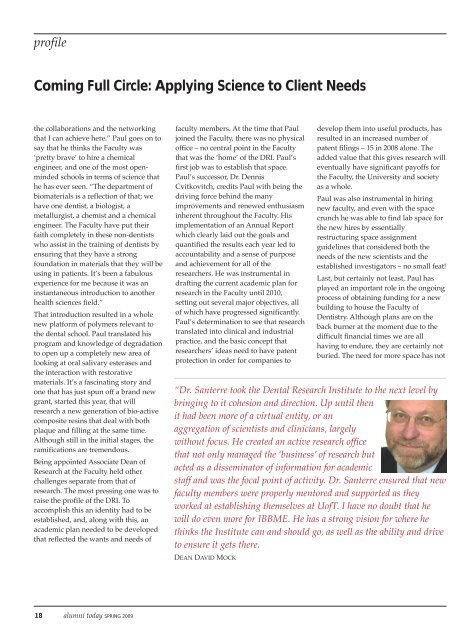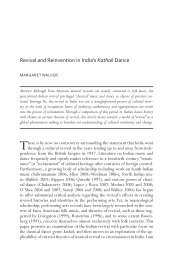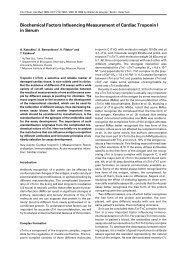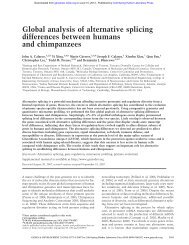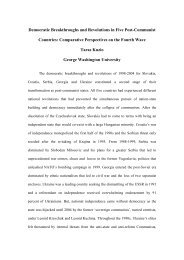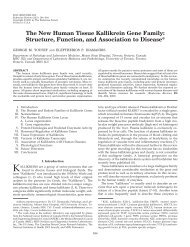Alumni Today - University of Toronto
Alumni Today - University of Toronto
Alumni Today - University of Toronto
You also want an ePaper? Increase the reach of your titles
YUMPU automatically turns print PDFs into web optimized ePapers that Google loves.
pr<strong>of</strong>ile<br />
Coming Full Circle: Applying Science to Client Needs<br />
the collaborations and the networking<br />
that I can achieve here.” Paul goes on to<br />
say that he thinks the Faculty was<br />
‘pretty brave’ to hire a chemical<br />
engineer, and one <strong>of</strong> the most openminded<br />
schools in terms <strong>of</strong> science that<br />
he has ever seen. “The department <strong>of</strong><br />
biomaterials is a reflection <strong>of</strong> that; we<br />
have one dentist, a biologist, a<br />
metallurgist, a chemist and a chemical<br />
engineer. The Faculty have put their<br />
faith completely in these non-dentists<br />
who assist in the training <strong>of</strong> dentists by<br />
ensuring that they have a strong<br />
foundation in materials that they will be<br />
using in patients. It’s been a fabulous<br />
experience for me because it was an<br />
instantaneous introduction to another<br />
health sciences field.”<br />
That introduction resulted in a whole<br />
new platform <strong>of</strong> polymers relevant to<br />
the dental school. Paul translated his<br />
program and knowledge <strong>of</strong> degradation<br />
to open up a completely new area <strong>of</strong><br />
looking at oral salivary esterases and<br />
the interaction with restorative<br />
materials. It’s a fascinating story and<br />
one that has just spun <strong>of</strong>f a brand new<br />
grant, started this year, that will<br />
research a new generation <strong>of</strong> bio-active<br />
composite resins that deal with both<br />
plaque and filling at the same time.<br />
Although still in the initial stages, the<br />
ramifications are tremendous.<br />
Being appointed Associate Dean <strong>of</strong><br />
Research at the Faculty held other<br />
challenges separate from that <strong>of</strong><br />
research. The most pressing one was to<br />
raise the pr<strong>of</strong>ile <strong>of</strong> the DRI. To<br />
accomplish this an identity had to be<br />
established, and, along with this, an<br />
academic plan needed to be developed<br />
that reflected the wants and needs <strong>of</strong><br />
18 alumni today SPRING 2009<br />
faculty members. At the time that Paul<br />
joined the Faculty, there was no physical<br />
<strong>of</strong>fice – no central point in the Faculty<br />
that was the ‘home’ <strong>of</strong> the DRI. Paul’s<br />
first job was to establish that space.<br />
Paul’s successor, Dr. Dennis<br />
Cvitkovitch, credits Paul with being the<br />
driving force behind the many<br />
improvements and renewed enthusiasm<br />
inherent throughout the Faculty. His<br />
implementation <strong>of</strong> an Annual Report<br />
which clearly laid out the goals and<br />
quantified the results each year led to<br />
accountability and a sense <strong>of</strong> purpose<br />
and achievement for all <strong>of</strong> the<br />
researchers. He was instrumental in<br />
drafting the current academic plan for<br />
research in the Faculty until 2010,<br />
setting out several major objectives, all<br />
<strong>of</strong> which have progressed significantly.<br />
Paul’s determination to see that research<br />
translated into clinical and industrial<br />
practice, and the basic concept that<br />
researchers’ ideas need to have patent<br />
protection in order for companies to<br />
develop them into useful products, has<br />
resulted in an increased number <strong>of</strong><br />
patent filings – 15 in 2008 alone. The<br />
added value that this gives research will<br />
eventually have significant pay<strong>of</strong>fs for<br />
the Faculty, the <strong>University</strong> and society<br />
as a whole.<br />
Paul was also instrumental in hiring<br />
new faculty, and even with the space<br />
crunch he was able to find lab space for<br />
the new hires by essentially<br />
restructuring space assignment<br />
guidelines that considered both the<br />
needs <strong>of</strong> the new scientists and the<br />
established investigators – no small feat!<br />
Last, but certainly not least, Paul has<br />
played an important role in the ongoing<br />
process <strong>of</strong> obtaining funding for a new<br />
building to house the Faculty <strong>of</strong><br />
Dentistry. Although plans are on the<br />
back burner at the moment due to the<br />
difficult financial times we are all<br />
having to endure, they are certainly not<br />
buried. The need for more space has not<br />
“Dr. Santerre took the Dental Research Institute to the next level by<br />
bringing to it cohesion and direction. Up until then<br />
it had been more <strong>of</strong> a virtual entity, or an<br />
aggregation <strong>of</strong> scientists and clinicians, largely<br />
without focus. He created an active research <strong>of</strong>fice<br />
that not only managed the ‘business’ <strong>of</strong> research but<br />
acted as a disseminator <strong>of</strong> information for academic<br />
staff and was the focal point <strong>of</strong> activity. Dr. Santerre ensured that new<br />
faculty members were properly mentored and supported as they<br />
worked at establishing themselves at U<strong>of</strong>T. I have no doubt that he<br />
will do even more for IBBME. He has a strong vision for where he<br />
thinks the Institute can and should go, as well as the ability and drive<br />
to ensure it gets there.<br />
DEAN DAVID MOCK


